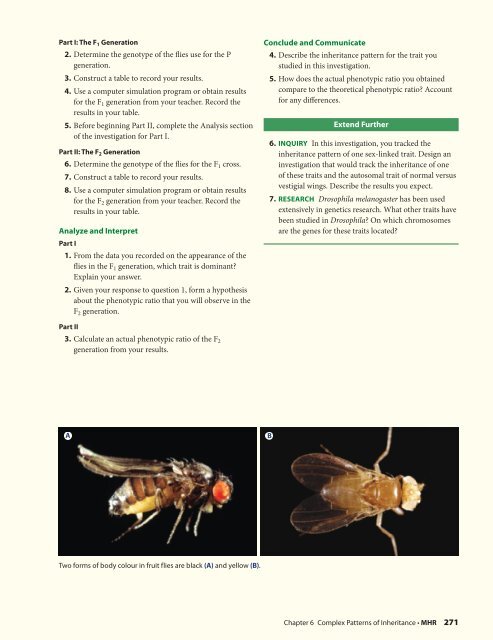REVIEW Chapter 6 - McGraw-Hill Ryerson
REVIEW Chapter 6 - McGraw-Hill Ryerson
REVIEW Chapter 6 - McGraw-Hill Ryerson
You also want an ePaper? Increase the reach of your titles
YUMPU automatically turns print PDFs into web optimized ePapers that Google loves.
Part I: The F 1 Generation<br />
2. Determine the genotype of the fl ies use for the P<br />
generation.<br />
3. Construct a table to record your results.<br />
4. Use a computer simulation program or obtain results<br />
for the F1 generation from your teacher. Record the<br />
results in your table.<br />
5. Before beginning Part II, complete the Analysis section<br />
of the investigation for Part I.<br />
Part II: The F2 Generation<br />
6. Determine the genotype of the fl ies for the F1 cross.<br />
7. Construct a table to record your results.<br />
8. Use a computer simulation program or obtain results<br />
for the F2 generation from your teacher. Record the<br />
results in your table.<br />
Analyze and Interpret<br />
Part I<br />
1. From the data you recorded on the appearance of the<br />
fl ies in the F1 generation, which trait is dominant?<br />
Explain your answer.<br />
2. Given your response to question 1, form a hypothesis<br />
about the phenotypic ratio that you will observe in the<br />
F2 generation.<br />
Part II<br />
3. Calculate an actual phenotypic ratio of the F2 generation from your results.<br />
A B<br />
Two forms of body colour in fruit flies are black (A) and yellow (B).<br />
Conclude and Communicate<br />
4. Describe the inheritance pattern for the trait you<br />
studied in this investigation.<br />
5. How does the actual phenotypic ratio you obtained<br />
compare to the theoretical phenotypic ratio? Account<br />
for any diff erences.<br />
Extend Further<br />
6. INQUIRY In this investigation, you tracked the<br />
inheritance pattern of one sex-linked trait. Design an<br />
investigation that would track the inheritance of one<br />
of these traits and the autosomal trait of normal versus<br />
vestigial wings. Describe the results you expect.<br />
7. RESEARCH Drosophila melanogaster has been used<br />
extensively in genetics research. What other traits have<br />
been studied in Drosophila? On which chromosomes<br />
are the genes for these traits located?<br />
<strong>Chapter</strong> 6 Complex Patterns of Inheritance • MHR 271

















